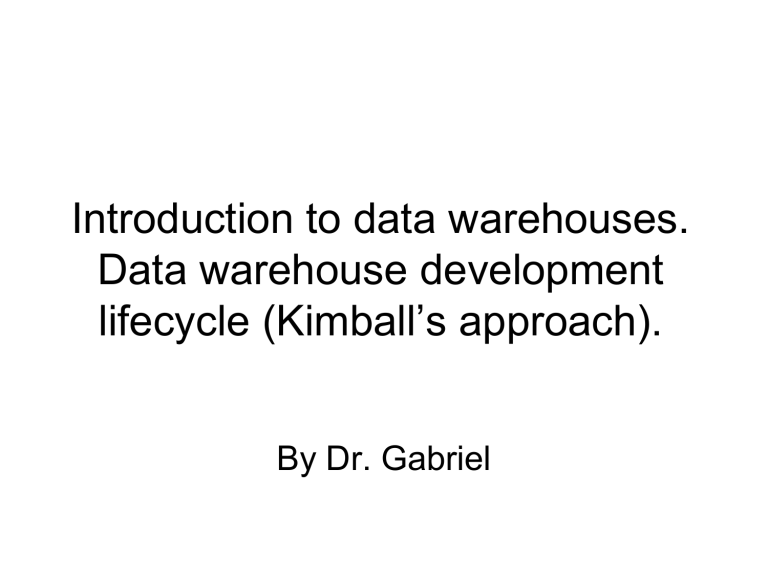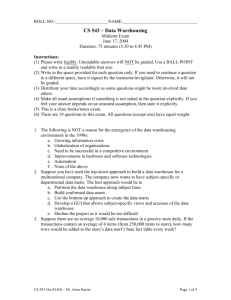The Kimball Lifecycle

Introduction to data warehouses.
Data warehouse development lifecycle (Kimball’s approach).
By Dr. Gabriel
Key Definitions
• Data mart is a specific, subject-oriented repository of data that was designed to answer specific questions
– Usually, multiple data marts exist to serve the needs of multiple business units (sales, marketing, operations, collections, accounting, etc.)
• Data warehouse is a single organizational repository of enterprise wide data across many or all subject areas.
– Data warehouse is an enterprise wide collection of data marts
Key Definitions
• “Business Intelligence” refers to reporting and analysis of data stored in the warehouse
• Data warehouse is the foundation for business intelligence.
• ‘‘Data warehouse/business intelligence’’
(DW/BI) refers to the complete end-to-end system.
Two Main Data Warehouse
Development Methodologies
• Top-down approach
– The Inmon’s approach
– DW is developed based on the Enterprise wide data model
– DW as a single repository feeds data into data marts
– Longer to implement
• May fail due to the lack of patience and commitment
• Bottom-up approach
– The Kimball’s approach
– Starts with one data mart (ex. sales); later on additional data marts are added (ex. collection, marketing, etc.)
– Data flows from source into data marts, then into the data warehouse
– Faster to implement
• Implementation in stages
– Need to ensure consistency of metadata
• Making sure each data mart calls Apple and Apple
• The Hybrid approach
The Kimball Lifecycle Diagram
The Kimball Lifecycle
• Illustrates the general flow of a DW implementation
• Identifies task sequencing and highlights activities that should happen concurrently
• May need to be customized to address the unique needs of your organization
• Not every detail of every Lifecycle task will be performed on every project
The Kimball Lifecycle,
SDLC, and DBLC
Planning
Analysis
Detailed System
Design
Implementation
Maintenance
DB Initial Study
DB Design
Implementation
Testing
Operation
Maintenance
Program/Project Planning
• Kimball’s view of programs and projects
– Project refers to a single iteration of the Kimball
Lifecycle
• from launch through deployment
– Program refers to the broader, ongoing coordination of resources, infrastructure, timelines, and communication across multiple projects
• a program contains multiple projects
– In real world, programs do not necessarily start before projects although ideally they should be.
Program/Project Planning
• Project planning
– Scope definition understanding business requirements
– Tasks’ identification
– Scheduling
– Resource planning
– Workload assignment
– The end document represents a blueprint of the project
Program/Project Management
• Enforces the project plan
• Activities:
– Status monitoring
– Issue tracking
– Development of a comprehensive communication plan that addresses both the business and IT units
Business Requirements Definition
• Success of the project depends on a solid understanding of the business requirements!!!
• Understanding the key factors driving the business is crucial for successful translation of the business requirements into design considerations
What follows the business requirements definition?
• 3 concurrent tracks focusing on
– Technology
– Data
– Business intelligence applications
– Arrows in the diagram indicate the activity workflow along each of the parallel tracks
– Dependencies between the tasks are illustrated by the vertical alignment of the task boxes.
Technology Track
• Technical Architecture Design
– Overall architectural framework and vision
– Considerations:
• the business requirements
• current technical environment
• planned strategic technical directions
Technology Track
• Product Selection and Installation
– Based on the designed technical architecture
• Evaluation and selection of
– Products that will deliver needed capabilities
– Hardware platform
– Database management system
– Extract-transformation-load (ETL) tools
– Data access query tools
– Reporting tools must be evaluated
• Installation of selected products/components/tools
• Testing of installed products to ensure appropriate end-to-end integration within the data warehouse environment.
Data Track
• Design of the dimensional model
• The physical design of the model
• Extraction, transformation, and loading
(ETL) of source data into the target models.
Dimensional Modeling
• Detailed data analysis of a single business process is performed to identify the fact table granularity, associated dimensions and attributes, and numeric facts.
• Dimensional models contain the same data content and relationships as models normalized into third normal form, but structured differently.
– Improve understandability and query performance required by DW/BI
• Primary constructs of a dimensional model
– fact tables
– dimension tables
Dimensional Modeling
• Fact tables
– Contain the metrics resulting from a business process or measurement event, such as the sales ordering process or service call event
– Dimensional models should be structured around business processes and their associated data sources,
• This results in ability to design identical, consistent views of data for all observers, regardless of which business unit they belong to, which goes a long way toward eliminating misunderstandings at business meetings
– Fact table’s granularity should be set at the lowest, most atomic level captured by the business process
• This allows for maximum flexibility and extensibility.
– Business users will be able to ask constantly changing, freeranging, and very precise questions.
Dimensional Modeling
• Dimensional table
– Contain the descriptive attributes and characteristics associated with specific, tangible measurement events, such as the customer, product, or sales representative associated with an order being placed.
– Dimension attributes are used for constraining, grouping, or labeling in a query.
– Hierarchical many-to-one relationships are denormalized into single dimension tables.
Star Schema
• A fact table
• Multiple dimension tables
• Example:
Assume this schema to be of a retail-chain. Fact will be revenue (money). How do you want to see data is called a dimension.
Snowflake Schema
• The snowflake schema is a variation of the star schema used in a data warehouse.
• The snowflake schema is a more complex schema than the star schema because the tables which describe the dimensions are normalized.
Snowflake Schema
• Disadvantages:
– Fact tables are typically responsible for 90% or more of the storage requirements, so the benefit is normally insignificant.
– Normalization of the dimension tables ("snowflaking") can impair the performance of a data warehouse.
• Advantages:
– If a dimension is very sparse (i.e. most of the possible values for the dimension have no data) and/or a dimension has a very long list of attributes which may be used in a query, the dimension table may occupy a significant proportion of the database and snowflaking may be appropriate.
• In practice, many data warehouses will normalize some dimensions and not others, and hence use a combination of snowflake and classic star schema.
Physical Design
• Defining the physical structures
– setting up the database environment
– Setting up appropriate security
– preliminary performance tuning strategies, from indexing to partitioning and aggregations.
– If appropriate, OLAP databases are also designed during this process.
ETL Design and Development
• The MOST important stage
• 70% of the risk and effort in the DW project is attributed to this stage
• ETL system capabilities:
– Extraction
– Cleansing and conforming
– Delivery and management
ETL
• Raw data is extracted from the operational source systems and is being transformed into meaningful information for the business
• ETL processes must be architected long before any data is extracted from the source
• ETL system strives to deliver high throughput, as well as high quality output
• Incoming data is checked for reasonable quality
• Data quality conditions are continuously monitored
• Kimball calls ETL a “data warehouse back room”
Business Intelligence
Application Track
• Applications that query, analyze, and present information from the dimensional model.
• BI applications deliver business value from the DW/BI solution, rather than just delivering the data
• The goal is to deliver capabilities that are accepted by the business to support and enhance their decision making.
• BI Application Design
– Identify the candidate BI applications and appropriate navigation interfaces to address the users’ needs and needed capabilities.
– Produce BI application specification
• BI Application Development
– Configuration of the business metadata and tool infrastructure
– Construction and validation of the specified analytic and operational BI applications and the navigational portal
Deployment
• It is crucial that adequate planning was performed to make sure that:
– the results of technology, data, and BI application tracks are tested and fit together properly
– Appropriate education and support infrastructure is in place.
• It is critical that deployment be well orchestrated
• Deployment should be deferred if all the pieces, such as training, documentation, and validated data, are not ready for production release.
Maintenance
• Occurs when the system is in production
• Includes:
– technical operational tasks that are necessary to keep the system performing optimally
• usage monitoring
• performance tuning
• index maintenance
• system backup
– Ongoing support, education, and communication with business users
Growth
• DW systems tend to expand (if they were successful)
– Is considered as a sign of success
– New requests need to be prioritized
– Starting the cycle again
• Building upon the foundation that has already been established
• Focusing on the new requirements







